1. 개요:
- 제목: ALUMINUM HIGH PRESSURE VACUUM DIE CASTING APPLICATIONS FOR THE MULTI MATERIAL LIGHTWEIGHT VEHICLE PROGRAM (MMLV) BODY STRUCTURE
- 저자: Randy Beals¹, Jeff Conklin¹, Tim Skszek¹, Matt Zaluzec², David Wagner²
- 발행 연도: 2015
- 발행 학술지/학회: Light Metals 2015, TMS (The Minerals, Metals & Materials Society)
- 키워드: 알루미늄, 고압 진공 다이캐스팅, 차체 구조
2. 연구 배경:
연구는 2012년 Magna International, 미국 에너지부, Ford Motor Company가 공동으로 시작한 다재료 경량 차량(MMLV) 프로젝트의 일환으로 진행되었다. 기존 차량의 무게 감량을 통한 연비 개선 및 배출가스 저감이라는 사회적 요구와, 기존의 단일 소재(강철, 고강도 강판 또는 알루미늄) 차체 설계의 한계(높은 비용, 기존 공정과의 비호환성, 글로벌 생산 능력 부족)를 극복하기 위한 연구의 필요성에 기인한다. 기존 연구들은 단일 소재 솔루션에 집중했으나, 다재료 접근 방식은 부품 단위 통합에 국한되어 있었다.
3. 연구 목적 및 연구 질문:
- 연구 목적: MMLV 차량의 경량화된 차체 구조 설계에서 알루미늄 고압 진공 다이캐스팅(hpvdc) 부품의 무게 감소 효과와 성능을 평가하는 것.
- 핵심 연구 질문: 알루미늄 hpvdc 부품을 통합한 다재료 차체 구조가 기존 차량 대비 얼마나 무게를 줄이고, 강성, 내구성, 충돌 안전성을 어떻게 유지하는가?
- 연구 가설: 알루미늄 hpvdc 부품을 전략적으로 사용하면 기존 강철 차체 대비 무게를 감소시키면서 충돌 성능 및 조립 비용을 개선할 수 있다.
4. 연구 방법론:
- 연구 설계: MMLV 프로젝트를 통해 제작된 시제품 차량을 대상으로 알루미늄 hpvdc 부품의 무게 감소 효과와 성능을 분석하는 실증 연구.
- 데이터 수집 방법: MMLV 차량의 차체 구조 설계, 제작 과정, 성능 시험 결과(강성, 내구성, 충돌 안전성) 데이터를 수집.
- 분석 방법: 알루미늄 hpvdc 부품을 포함한 MMLV 차체 구조의 무게, 강성, 내구성, 충돌 성능 등을 정량적으로 분석하고, 기존 차량과 비교. MAGMASOFT® 소프트웨어를 이용한 주조 시뮬레이션으로 주조 공정 최적화.
- 연구 대상 및 범위: MMLV 프로젝트에서 제작된 시제품 차량의 차체 구조(BIW). 8개의 hpvdc 알루미늄 주조 부품, 6개의 알루미늄 압출형, 12개의 주요 강철 스탬핑, 다수의 알루미늄 스탬핑 등이 포함.
5. 주요 연구 결과:
- 핵심 발견사항: MMLV 차량은 2013년 Ford Fusion 모델 대비 23.5% (1170 kg vs 1559 kg)의 무게 감량을 달성했다. 이는 알루미늄 hpvdc 부품의 사용이 크게 기여.
- 통계적/정성적 분석 결과: BIW 구조의 63%가 알루미늄, 37%가 강철로 구성. 8개의 hpvdc 부품을 사용하여 부품 수를 32개 줄이고 강성을 높였음. 충돌 시뮬레이션 결과, 기존 차량 대비 개선된 충돌 안전성 확인.
- 데이터 해석: 알루미늄 hpvdc 주조 기술은 경량화, 부품 통합, 조립 공정 단순화 등을 통해 차체 구조의 무게 감량과 성능 향상에 기여. 저압 정밀 사형 주조 기술을 통해 hpvdc 부품과 유사한 성능을 확보. 다양한 접합 기술(SPR, CMT 용접, 접착제)을 사용하여 다재료 차체 구조 구현.
- Figure List:
- Figure 1. MMLV concept vehicle
- Figure 2. MMLV BIW Design
- Figure 3. MMLV BIW concept prototype
- Figure 4. MMLV BIW showing hpvdc castings
- Figure 5. MMLV vacuum die cast shock tower casting x-ray
- Figure 6. MMLV kick down rail, Magmasoft Casting Fill Simulation
- Figure 7. MMLV aluminum shock tower casting
- Figure 8. MMLV aluminum shock tower casting joined to the front end assembly by SPR and CMT methods
- Figure 9. MMLV kick down rail
- Figure 10. MMLV Frontal 40% off-set impact FEA with improved intrusion over baseline
- Figure 11. MMLV hinge pillar
- Figure 12. MMLV hinge pillar casting one sided joining with flow drill screws
- Figure 13. MMLV mid rear rail
- Figure 14. MMLV mid rear rail assembly
- Figure 15. SPR of MMLV shock tower casting to front rail
- Figure 16. MMLV cast aluminum hinge pillar to cast aluminum extruded rail TIG weld.
- Figure 17. MMLV TIG weld detail
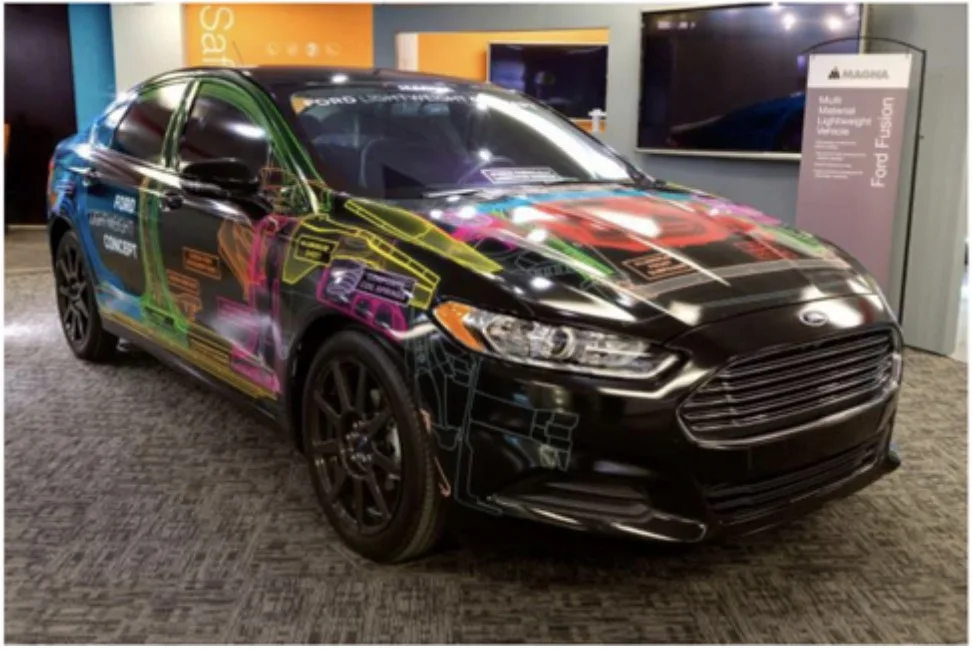
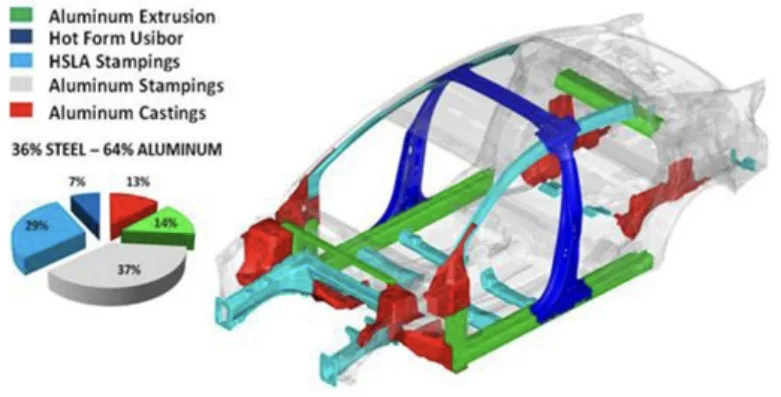
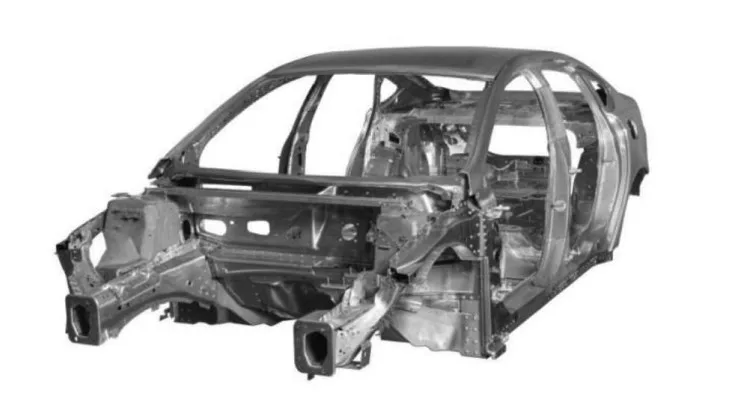
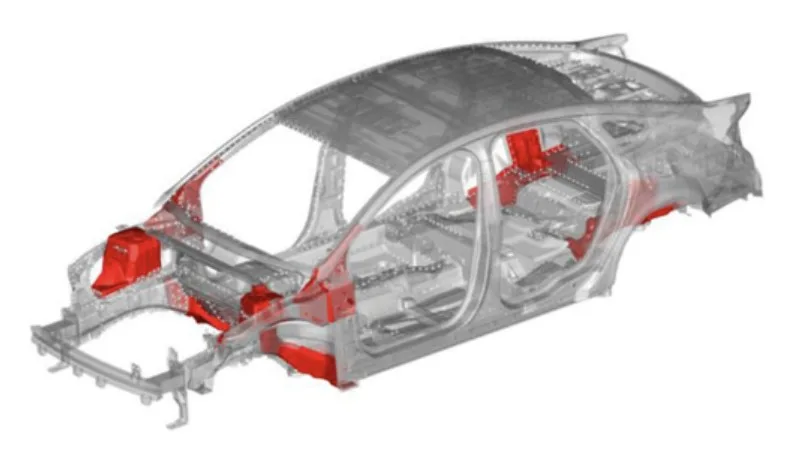
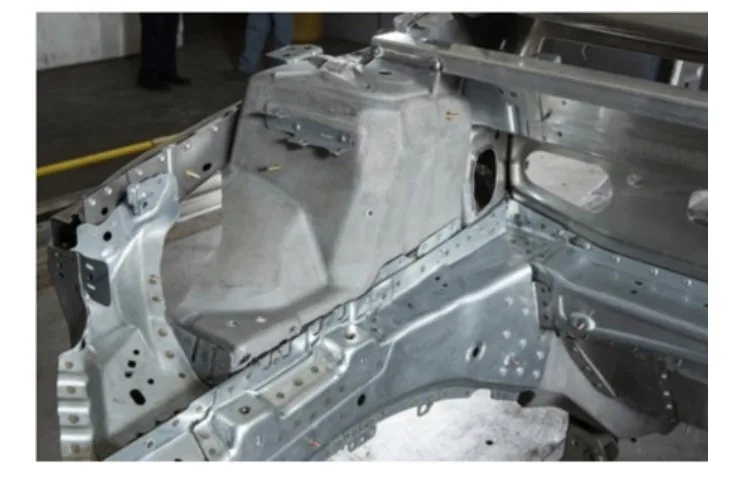
6. 결론 및 논의:
MMLV 프로젝트는 알루미늄 hpvdc 부품을 활용한 다재료 차체 구조 설계의 효과를 입증했다. 무게 감량과 함께 강성, 내구성, 충돌 안전성을 확보하고, 부품 수 감소를 통한 조립 비용 절감 효과를 거뒀다. 다만, 저압 정밀 사형 주조 기술을 활용한 부분과 소량 생산에 따른 비용 고려는 추가 연구가 필요한 부분이다.
7. 향후 후속 연구:
알루미늄 hpvdc 기술의 고강도 강판 및 다른 고성능 소재와의 조합을 통한 경량화 연구, 대량 생산을 위한 공정 최적화 연구, 다양한 접합 기술의 성능 및 경제성 분석, 그리고 다양한 차체 형태 및 크기로 확장 적용을 위한 추가 연구가 필요하다.
8. 참고문헌:
- Aluminum Alloys and Manufacturing Processes for Automotive Structural Applications, Alan Luo, The Ohio State University, TMS 2014
- The Aluminum Advantage Commercial Vehicle Applications, Todd Summe, Technical Committee, The Aluminum Association's Aluminum Transportation Group Division, SAE 2012
- Cost Effectiveness of a Lightweight Design for 2017- 2020: An Assessment of a Midsize Crossover Utility Vehicle, Cheryl Caffrey, Kevin Bolon, Hugh Harris (EPA), Greg Kolwich (FEV Inc.), Robert Johnston (EDAGInc.), SAE 2012
- Cost-Effectiveness of a Lightweight BIW Design for 2020-2025: An Assessment of a Midsize Crossover Utility Vehicle Body Structure; Gregory Peterson, Andrew Peterson, Lotas Engineering Inc, SAE 2013
- The Past, Present and Future of Aluminum in North American Light Vehicles, Dick Schultz, Ducker, October 2012
- Heat Treating of High Pressure Die Castings; Challenges and Possibilities: Salem Seifeddine, Swerea SWECAST and Darya Poletaeva, Jönköping University, TMS 2014.
- The application of multiphase steel in tlie Body-inWliite, Markus Pfestorf, BMW AgH
- A Lightweight Automobile Body Concept Featuring Ultra-Large, Ήιίη-Wall Structural Magnesium Castings, Steve Logan, Chrysler, SAE 2007.
- A Process of Decoupling and Developing Body Structare for Safety Performance, John Madakacherry, Martin Isaac, General Motors, 5th European LS-DYNA Users Conference, 2005.
- Recent Advancements on Porosity Simulation in High Pressure Die Casting, Chung Wliee Kim, Kimio Kubo, EKK Inc., AFS 2005.
- Light-Weighting the 2013 Cadillac ATS Body Structare, Warren J. Parsons, General Motors, Great Designs in Steel 2012.
- High Integrity Diecasting for Structural Applications, Martin Hartlieb, Viami International Inc, iMdc meeting, WPI, Worcester Mass, 2013.
- 2013 Ford Fusion, Shawn Morgans, Ford Motor co., Euro Car Body Conference 2012.
- Challenges and opportunities relative to increased usage of aluminum within the automotive industry, Blair Carlson, Paul Krajewski, Anil Sachdev, Jim Schroth, David Sigler, Mark Verbrugge, General Motors R&D, Warren, MI, TMS 2010
- Trends in Automotive - Aluminum, Doug Richman, Aluminum Association's Transportation Group (ATG), OPC Meeting, Aim Arbor, MI, July 16, 2013
- The Future of Aluminum Use in tlie Auto Industry, Alcoa, October 31,2013
- Future Material Opportunities and Direction for Lightweighting Automotive Body Structures, Marcel Camion, General Motors, February 9, 2012
- The Increasing Use of Aluminum: Prospects and Implications, John Hartley, European Commission Institute for Prospective Technological Studies, Nov 1996
저작권:
본 자료는 [논문 작성자]의 논문: [논문 제목]을 기반으로 작성되었습니다.
논문 출처: [DOI URL]
본 자료는 위 논문을 바탕으로 요약 작성되었으며, 상업적 목적으로 무단 사용이 금지됩니다.
Copyright © 2025 CASTMAN. All rights reserved.